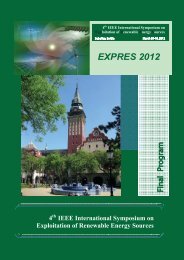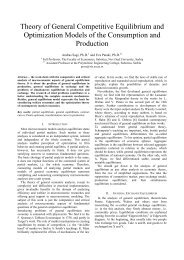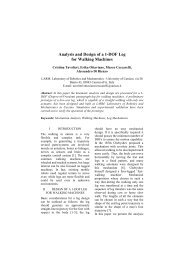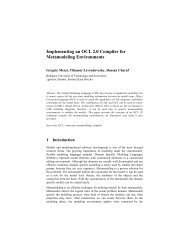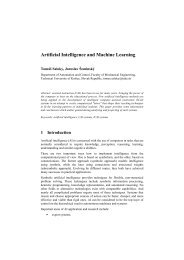Modeling and control of a 4-wheel skid-steering ... - University of Haifa
Modeling and control of a 4-wheel skid-steering ... - University of Haifa
Modeling and control of a 4-wheel skid-steering ... - University of Haifa
You also want an ePaper? Increase the reach of your titles
YUMPU automatically turns print PDFs into web optimized ePapers that Google loves.
lations are presented. Next, experimental verification using small four-<strong>wheel</strong> SSMR<br />
(see Fig. 1) is described <strong>and</strong> some results <strong>of</strong> experiments are given.<br />
2 Model <strong>of</strong> the robot<br />
2.1 Introduction<br />
In this section kinematic <strong>and</strong> dynamic model <strong>of</strong> four-<strong>wheel</strong> <strong>skid</strong>-<strong>steering</strong> mobile<br />
robot is presented. We refer to the real experimental construction consists <strong>of</strong> two<strong>wheel</strong><br />
differentially driven mobile robots namely MiniTracker 3 (see Fig.1) [9].<br />
In order to simplify the mathematical model <strong>of</strong> SSMR we assume that [2]<br />
• plane motion is considered only,<br />
• achievable linear <strong>and</strong> angular velocities <strong>of</strong> the robot are relatively small,<br />
• <strong>wheel</strong> contacts with surface at geometrical point (tire deformation is neglected),<br />
• vertical forces acting on <strong>wheel</strong>s are statically dependent on weight <strong>of</strong> the vehicle,<br />
• viscous friction phenomenon is assumed to be negligible.<br />
2.2 Kinematics<br />
Firstly, consider a vehicle moving on two dimensional plane with inertial coordinate<br />
frame (X g ,Y g ) as depicted in Fig. 1(a). To describe motion <strong>of</strong> the robot it is<br />
convenient to define an local frame attached to it with origin in its center <strong>of</strong> mass<br />
(COM). Assume that q [ X Y θ ] T<br />
∈ R 3 denotes generalized coordinates,<br />
where X, Y determine COM position <strong>and</strong> θ is an orientation the local frame with<br />
respect to the inertial frame, respectively.<br />
Let v [ ] T<br />
v x v y ∈ R 2 be a velocity vector <strong>of</strong> COM expressed in the local<br />
frame with v x <strong>and</strong> v y determining longitudinal <strong>and</strong> lateral velocity <strong>of</strong> the vehicle<br />
[4].<br />
From Fig. 1(a) it is easy to derive kinematic equation <strong>of</strong> motion using rotation matrix<br />
as follows ⎡ ⎤ ⎡<br />
⎤⎡<br />
⎤<br />
Ẋ cos θ −sin θ 0 v x<br />
˙q = ⎣ Ẏ ⎦ = ⎣ sinθ cos θ 0 ⎦⎣<br />
v y<br />
⎦, (1)<br />
˙θ 0 0 1 ω<br />
where ˙q ∈ R 3 is the generalized velocity vector <strong>and</strong> ω denotes angular velocity <strong>of</strong><br />
the vehicle.



